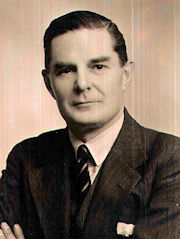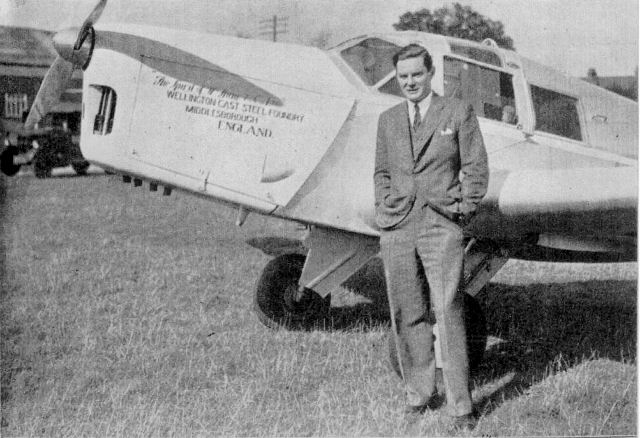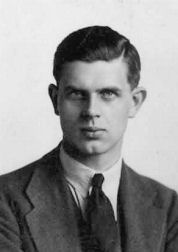| Wing-Cmdr (AAF) Geoffrey Shaw DFC | ||
|
|
|
|
|
[with family insights kindly provided by Louise Wilkinson, author of 'The Kipper Patrol', who interviewed Geoffrey's wife in October 2009] Geoffrey was born in Saltburn by the Sea, Yorkshire, in 1902, the second of 5 boys whose mother died at the age of 32 when he was 7. His father, who owned the Wellington Cast Steel Foundry in nearby Middlesborough, was unable to cope with the five boys, so Geoffrey was sent to public school in Scotland. He then studied engineering at Cambridge; whilst there, he met a friend who wanted to learn to fly, so the two of them went and found someone who could teach them both. After Cambridge, he went back to work in the family business, Wm Shaw & Co Ltd. "He was a very good engineer. He never reckoned he was very smart at anything learning wise, I don’t think any one else did either, but he was very good at all kinds of sport. "He found a small aerodrome where he could continue flying to build up his hours." NEWCASTLE-UPON-TYNE AERO CLUB REPORT for week ending June 5, 1927. —-Total flying time : 33 hrs. 10 mins. Dual with Mr. Parkinson :—Mrs. Heslop, Miss Leathart, Dr. Watt, Messrs.Elmes, Thirlwell, Heaton, Jewett, Wilson, G. Shaw, Gibson, George, Macalpine Downie, Pargeter, Bainbridge, and Capt. Milburn. Solo :—Capt. Milburn. Miss Leathart, Drs. Dixon and Watt, Messrs. Leech, R. N. Thompson, C. Thompson, Mathews, H. Ellis, Turnbull and W. B. Ellis. Report for week ending June 12. Dual with Mr. Parkinson :—Sir J. Reed, Craig, Elmes, Jewett, Thirlwell,Gibson. Heaton, Turnbull, Wilson, Phillips, H. Ellis, Davey, Miss Leathart, and Mrs. Heslop. Solo :—Miss Leathart, Messrs. Turnbull. H. Ellis, R. X. Thomspson, C. Thompson, Leech, W. B. Ellis, Phillips, Dixon, Todd and Mathews. Report for week ending June 19.—Total flying time : 23 hrs. 20 mins. Dual with Mr. Parkinson :—Mrs. Heslop, Messrs. Rasmussen, Elmes, Jewett, Heaton, Turnbull, Wilson, Irving, W. Todd, Davey, Maxwell, Pargeter,and Flying-Officer Dawson. Solo :—Flying-Officer Dawson. Dr. Dixon, H. Ellis, Turnbull, C. Thomson, R. N. Thompson, Mathews, W. B. Ellis. On Tuesday, Mr. Parkinson flew to Edinburgh, returning with Sir Sefton Brancker. After tea. Sir Sefton Brancker continued his journey to Sherburn in a Yorkshire Club Moth piloted by Mr. Fielden. Friday saw LX off service, and gales prevented any flying on Saturday and Sunday. The Secretary is still confined to his bed, but it is a pleasure to report that he is making slow but steady progress." [Interesting to see that his contemporaries in Newcastle included Connie Leathart; Geoffrey finally got his aviator's certificate, No 9,240, on the 21 June 1930, at the Newcastle Aero Club.
"When the Auxiliary Air Force was created, he was very keen to join so he went straight to 608 Squadron at Thornaby Aerodrome." [No. 608 Squadron was formed at Thornaby-on-Tees, North Yorkshire as No. 608 County of York (North Riding) Squadron, on 17 March 1930.] Geoffrey then transferred to the Yorkshire Aero Club, at Yeadon: July 8, 1932 "Six members joined the Yorkshire Aeroplane Club during June, amongst them being Mr. Geoffrey Shaw and Mr. A. C. Thornton. The latter is the designer of the 'Arrow Active', and his latest production, the 'Active II', has been much in evidence, being tested by F/O.H. H. Leech." "He bought a small aeroplane for £60, it was absolutely gorgeous ... I learned to fly in it too. It had an open cockpit, which is the nicest place to learn to fly. Just 4 cylinders, it was as light as a feather ... he always let me fly it. If we got somewhere where we didn’t know he would say to me, wake me up before we land, I think he always thought he should be awake in case I mucked it."
The first aircraft registered to Geoffrey was a 1927-model Avro 594 Avian III, G-EBVA (he is listed as the 6th owner), followed by Avro 616 Avian IVM, G-ABMO, first registered in May 1931 to Francis Montague (although he doesn't look very happy about it):
And then, completely out of the blue in 1934 (he admitted he had never flown further than 'near Paris' before), Geoffrey decided to enter the "World's Greatest Air Race" - the MacRobertson Race from England to Australia. He bought a brand-new B.A. Eagle I, G-ACVU, in July 1934, and had a special inscription painted on it - "The Spirit of Wm Shaw and Co Ltd, Wellington Cast Steel Foundry, Middlesborough, ENGLAND"
He was allocated Race No 47. He bought his maps in late August, but wasn't sure they were accurate enough - and, he asked the organising committee, "What height should I fly at?" They replied, "We have no idea - you'll have to ask the people who sold you the aeroplane". ABC's Guide to the Macrobertson Race described him thus: "G Shaw, a member of a wealthy Yorkshire family, recently resigned from the Royal Air Force. The fact that he was personal pilot to the late Sir Sefton Brancker, British Controller of Civil Aviation, is an indication of his flying calibre." [The 'personal pilot to Sefton Brancker' stuff is probably nonsense - Brancker, together with Lord Thomson, the Air Minister, was killed in the disastrous wreck of the R101 airship near Beauvais, France early on 5 October 1930, during its maiden voyage to India. Geoffrey only got his aviator's certificate a few months before that.] He got as far as Baghdad, though, before retiring with 'gear trouble', so got his £10 entrance fee back. Geoffrey married Elizabeth in July 1935; here they are with the Eagle during a Hungarian Holiday in August.
He then sold the aeroplane, and it later crashed into the sea off Corsica, on 13 Apr 1936. Geoffrey continued with 608 Sqn, eventually taking over from Geoffrey Ambler: The Times Nov 11 1938: "Royal Air Force Squadron Leader G. H. Ambler has relinquished the command of No. 608 (North Riding) (Fighter) Squadron of the Auxiliary Air Force, which he had held since December, 1934. He had served with the squadron since February 1931, a few months after it was established. His successor is Flight Lieutenant Geoffrey Shaw, who is granted the acting rank of squadron leader from October 30. He has been with the squadron since August, 1930, and has held the rank of flight lieutenant since 1933. No. 608 was originally a bomber squadron, and was converted for fighter duties in January 1937, when it exchanged its Wapiti bombers for Demon fighters."
Geoffrey bought himself another aeroplane; G-ADVH, a GAL Monospar Jubliee, from Albert Batchelor of Ramsgate. This aeroplane was impressed in March 1940 as X9365, but crashed at Saighton Camp 3 weeks later. When WWII broke out, Geoffrey continued with 608 Sqn and was promoted to Wing Commander: "By September 19th 1939, the squadron was available for anti-submarine patrol from 0600 hours to 1600 hours with four Ansons on standby, but the first operational flight of 608 Squadron was not made until the 21st. of September 1939, when an Anson serial number N5207, was flown by Squadron Leader G. Shaw, Flying Officer Woolcock and crewed by L.A.C. Kelly and Corporal Knott, who took off on an anti-submarine patrol in response to a false alarm. THE KIPPER PATROL Remembered by some veterans as “the kipper patrol”, their job, as part of Coastal Command, involved protecting shipping convoys, looking for submarines and defending the northern supply routes. Although their role was never seen as glamorous and never received national glory, nonetheless, they played a significant part in the defence of the United Kingdom. This book tells the story of young pilots such as Geoffrey Ambler, Geoffrey Shaw, William Appleby-Brown and Peter Vaux, and airmen such as Albert Guy, Harold Coppick and Syd Buckle, and considers how their lives were dramatically changed with the onset of the Second World War, which saw them cease to be part-timers and become full time members of the Royal Air Force. http://www.pneumasprings.co.uk/The%20Kipper%20Patrol.htm He was Mentioned in Despatches in July 1940, and awarded the DFC on 6 March, 1941. "I still don’t know what he got his DFC for in 1941. He never told me anything about his work." He continued flying after WWII; here is his post-war aviator's certificate:
Geoffrey died, after a long illness, in 1977 in Malta, aged 75. He is buried there. "There are no photos of him left as he burnt them all one afternoon after the war ended." |
||

 1934, before the MacRobertson Race
1934, before the MacRobertson Race 1947
1947
 Avro Avian
Avro Avian
 Geoffrey with the Eagle, via Louise Wilkinson
Geoffrey with the Eagle, via Louise Wilkinson
 Geoffrey Hill Ambler (q.v.)
Geoffrey Hill Ambler (q.v.)
